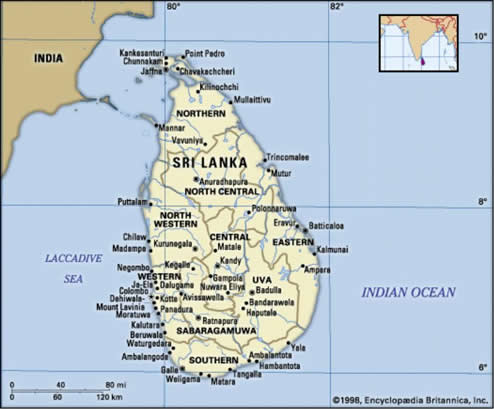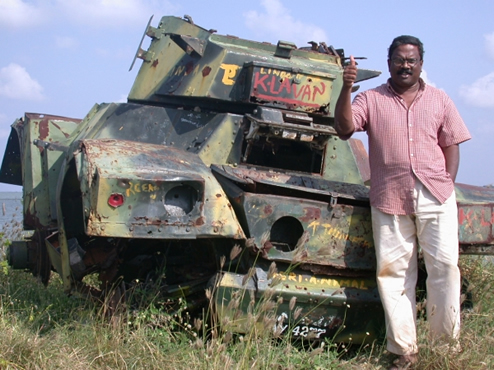SANGAM.ORG
Ilankai Tamil Sangam, USA, Inc.
Association of Tamils of Sri Lanka in the USA
What is the Larger Picture in Pirapakaran's Mind?
by Taraki, Daily Mirror, March 9, 2005
|
[This article reminds one that rereading D. Sivaram's writings is always productive, and why we miss his insight so deeply. --Ed.]
|
The violence in Batticaloa and its border with Polonnaruwa is taking a momentum of its own and looks set to spiral out of control. But ultimately whether all this would lead to war is in the hands of the Sri Lankan government and the LTTE. War is their decision. People are fast losing a sense of the larger picture.

Sinhala nationalists who felt immensely let down by Karuna's ignominious flight from Batticaloa last year are cheering that the renegade is back with a vengeance. Many enthusiastic punters in Colombo's opinion making circles are 'knowledgeably' betting on the 'dark horse' again.
This column tries deliberately to be the 'other voice' in this scene, out of tune with the litany that saturates the political atmosphere on the southern side of this island's ethnic divide, so that people see a need to hedge their bets on the ethnic question. It is easy to jump on the bandwagon by saying 'Pirapakaran is losing' or 'down with the Tigers', if one wants to be feted and quoted. This is immoral - particularly when we see an increasingly collective compulsion in the Sinhala polity to hear only what people want to hear about the ethnic conflict.
It suits the LTTE's strategic purpose that 'Col. Karuna Amman' (as he is respectfully addressed by his southern admirers) is running a sideshow in the remote villages on the Batticaloa-Polonnaruwa border -- one that is firing up the enthusiasm of those who would rather see the LTTE finished than give Tamils a decent political settlement.
The singular inability in the south to grasp the strategic picture, to miss the wood for the trees is bewildering.
Why didn't Pirapakaran press the advantage in Jaffna?
The din of fire crackers that greeted the capture of Jaffna drowned a lone voice that urged the south to consider the fact that the LTTE had withdrawn from Jaffna with all its military assets and that there is no victory in war unless one breaks the enemy's will to fight and/or destroy a significant part off his/her military assets.
Again, during Operation Jaya Sikurui, the larger picture was lost sight of, amidst the grandiose claims of General Anuruddha Ratwatte.
Speaking about his days as the overall commander of the LTTE troops that were facing Op. Jaya Sikurui in the latter part of 2001, at Thenaham in Karadiyanaaru, Karuna told a group of Batticaloa journalists whom he had invited for lunch that he had often urged Pirapaharan that the Tigers should unleash their recently enhanced artillery and heavy mortar firepower to stop the advance of the Sri Lanka army.
"Every time I asked him he told me to wait, that he would tell me when and where to strike with the big guns. Let them spread out, he would say. But we were worried that the army was getting too close to Puthukudiyiruppu and Mullaithivu. Then one day he called me to headquarters and showed me a point on the map. He gave me a time frame and asked me to make preparations for a concentrated attack there. He also instructed me to prepare regular units and auxiliary forces to hold and consolidate large areas in the Vanni. When we overran that point, the gains of Op. Jaya Sikurui started falling like nine pins. But again when we were on the verge of sweeping over all of Manal Aaru (Weli Oya) we got orders from headquarters to stop.
The Jeyanthan Regiment boys were a bit disappointed at this. He and the fellows at the military science division were always studying the larger picture," said Karuna, proudly recounting his work with Pirapaharan during Op. Jaya Sikurui.
Karuna repeated the same story when he addressed a cheering audience in Oslo where he went to take part in peace talks in the Norwegian capital in December 2002.

Today, it is taken for granted that the LTTE did not walk into Jaffna because it was driven back by the army with the Multi-barrel Rocket Launchers it got from Pakistan. This is a fallacy. LTTE forces were at the gates of Jaffna months before the multi-barrels arrived. The order to stop came from the LTTE headquarters in Vanni. Why didn't Pirapakaran press the advantage in Jaffna? That the LTTE had reachedthe end of its tether militarily is not the whole explanation if one were to consider the manner in which the Tigers counterattacked the massive Op. Agni Khiela in April 2001.
What was the larger picture in Pirapakaran's mind that made him forego Jaffna or at least a large chunk of it? We don't know. But it is obvious that he had a political aim in mind. After all, in the larger picture, war is politics by other means.
So what is the greater strategic perspective in which the LTTE locates the current incidents in the east? What is it from which this sideshow is distracting the south?
We do not know exactly. But we may have a hunch from certain recent developments which are of concern to the army.
Balraj, the LTTE's most senior military commander, has been moved to the Vakarai region. Sri Lanka military intelligence thought he was killed by the tsunami after his personal communications went silent for five days from December 26, 2004.
But he was there in Vakarai to greet Thamilchelvan and show him around when the LTTE's political division leader visited the area last month.
Balraj has been in Vakarai for three months. What is the LTTE's most experienced and senior commander who taught war tactics and strategy to Karuna doing in a remote part of Batticaloa? The army's Psychological Operations Directorate might come up with the fantastic explanation that he had been sent to the area because of differences with Pirapakaran - like the puerile fabrication about Soosai. But wise men in the Sri Lanka army who are not swayed by the oft shifting winds of media moods in the south are quietly looking at the strategic possibilities arising from Balraj's stay in the Vakarai - particularly because it is a key sector of the soft underbelly of the port of Trincomalee.
That Pirapakaran has sent three of his most important commanders to the north and south of Trincomalee is of greater concern to the military than the sideshow on the Polonnaruwa-Batticaloa border. A fourth senior commander has been moved to a strategic point in the east with his command and control systems and troops.
The military has taken precautions by sending more artillery to Minneriya. Troops are now undergoing special combat training there.
What is the larger picture that Pirapakaran has in mind while the south is entertained by Karuna?
But the drama in Batticaloa-Polonnaruwa is so gripping that no one wants to be distracted by such 'academic' questions.
TamilNation maintains a good selection of Taraki's writings.
© 1996-2025 Ilankai Tamil Sangam, USA, Inc.

